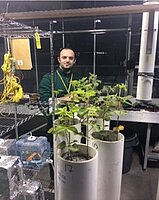Effect of Water Level on Soybean Growth with High Salinity Water

Yavuz F Fidantemiz is a Master of Science student in Agricultural & Biosystems Engineering at North Dakota State University. He obtained his B.S. degree from Farm Structure and Irrigation Department at Ondokuz Mayis University, Turkey. His present research is focused on understanding the yield and seed quality performance of soybean under certain groundwater depths.
Email: yavuz.fidantemiz@ndsu.edu
Fellow: Yavuz F Fidantemiz
Adviser: Halis Simsek
Effect of water table on soybean growth and yield parameters
North Dakota (ND) is one of the main states in the United States (US) where soybean is grown extensively. Groundwater contribution is important component affecting substantial growth and yields of soybean. Quantifying how much shallow groundwater can potentially be used for soybean growth can provide knowledge for scheduling irrigation and drainage systems. Climate, irrigation water quality, crop, soil type, and irrigation management are the parameters mostly affect the water table depth on any crop. However, shallow water table depth can cause water logging and oxygen depletions at the root zone. Necessary oxygen for both plants and organisms are depleted under shallow water table conditions. Evaporation is the main component of the water balance in arid and semi-arid areas. Evaporation process should be known for better water source planning and water management. Close correlation was found between evaporation rates and groundwater depth.
In this study, the effect of different water table depths on soybean growth and yield parameters and groundwater contributions to plants were investigated. The plants were grown in 15 cm diameter and 120 cm height soil columns. Soybean was subject to different water tables varied from 30 to 90 cm from the column surface during the growth period. Water content, temperature, and electrical conductivity were measured at certain depths to evaluate water vapor flux in the columns. As a control treatment, full irrigation was also applied. 30 PVC columns were used and each column was packed using same type of soils. 7.5-liter plastic Mariotte bottles were placed on the adjustable shelves, and each shelf’s height has been arranged for the desired water level of the particular water table. This is an ongoing study and has a plan to finalize through December 2018.
Significance of Research
Shallow groundwater can be considered alternative water resource for both dry and irrigated agriculture even though it is overlooked during the water management. A significant amount of water from shallow groundwater can be used by plants when the suitable conditions are met. It will be valuable for the farmers to know the water table effect on soybean plant since there is no irrigation application in North Dakota. A number of parameters such as groundwater depth, groundwater quality, crop growth stage, crop salt tolerance, irrigation frequency and application depth were affected from shallow groundwater level. Due to many parameters affecting groundwater contributions to the plant growth, it is hard to determine its effect in situ conditions. Currently, most of the irrigation programs only use irrigation water to determine the plant water demand and ignore groundwater contribution. Therefore, groundwater contribution should be taking into consideration. Applying column studies in a greenhouse condition could be a practical method to detect appropriate water demand for plants. Column study in a controlled environment is the best ways to simulate field condition and it has not been commonly studied so far. The results obtained from this study could help to reduce the risk of yield reduction in actual field application. In addition, the results will benefit the farm owner by giving information about soybean tolerance on water levels.
Significant Findings
At the beginning of the experiments, hydraulic properties of soil such as soil moisture release curve (SRC) and hydraulic conductivity were determined by using HYPROP®(Version 10/2011, UMS GmbH Munchen). The values of field capacity, critical point and permanent wilting point were determined. Based on the data from SRC, irrigation time and amount was scheduled.
Results showed that, since the water table has been fixed at the top of the columns to provide moisture for germination before planting, similar moisture percent has been monitored at 30 cm depth for the first month. In addition, similar plant heights and stages have been observed at the 30, 50, and 70 cm water table depths. However, the minimum plant heights were observed at 90 cm water table depth. More results will be available at the end of the experimental study.

Halis Simsek
AES Ag & Biosystems Eng
Office: ABEN 2016
Phone: 701-231-6107
Email: halis.simsek@ndsu.edu


